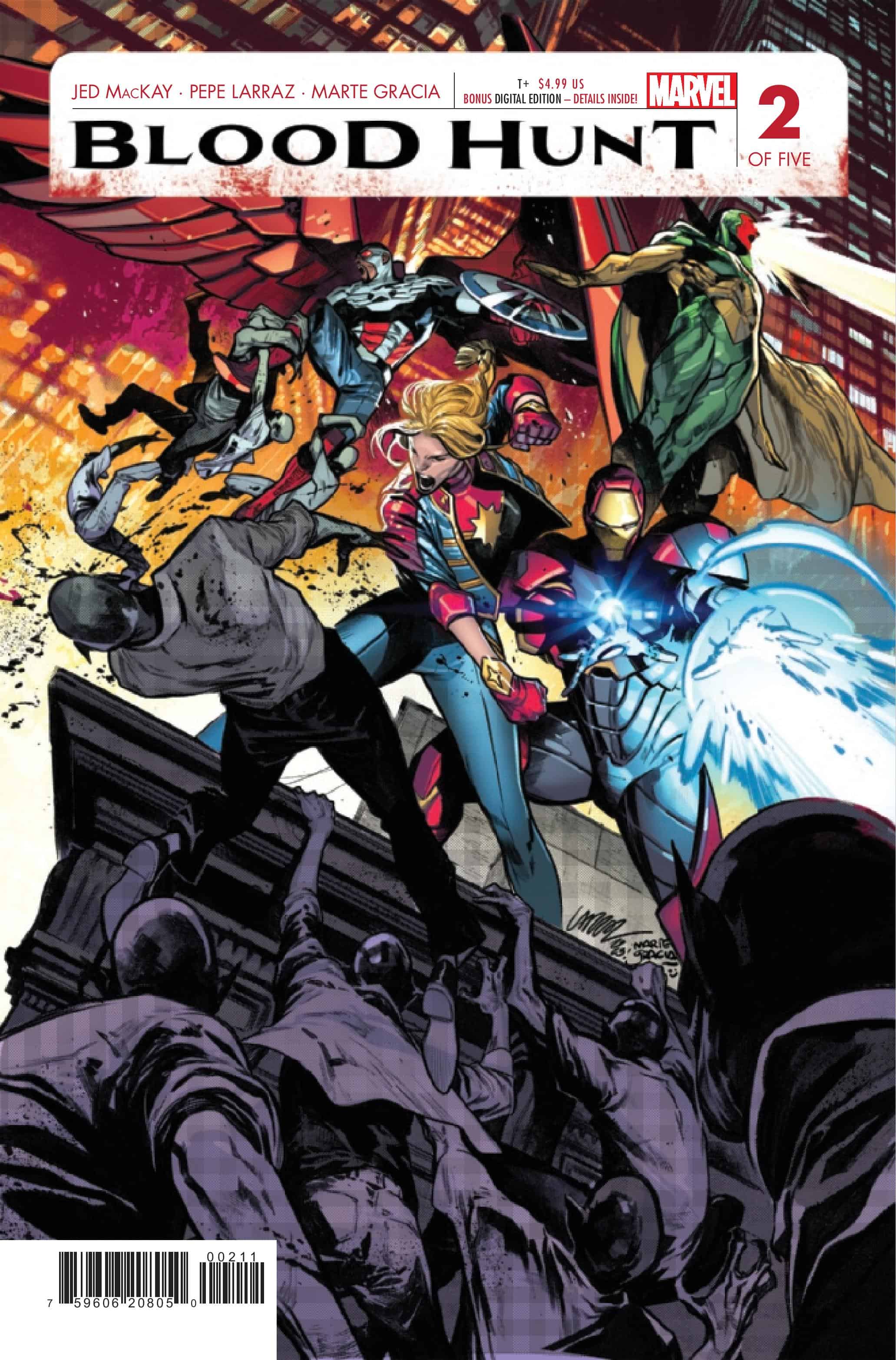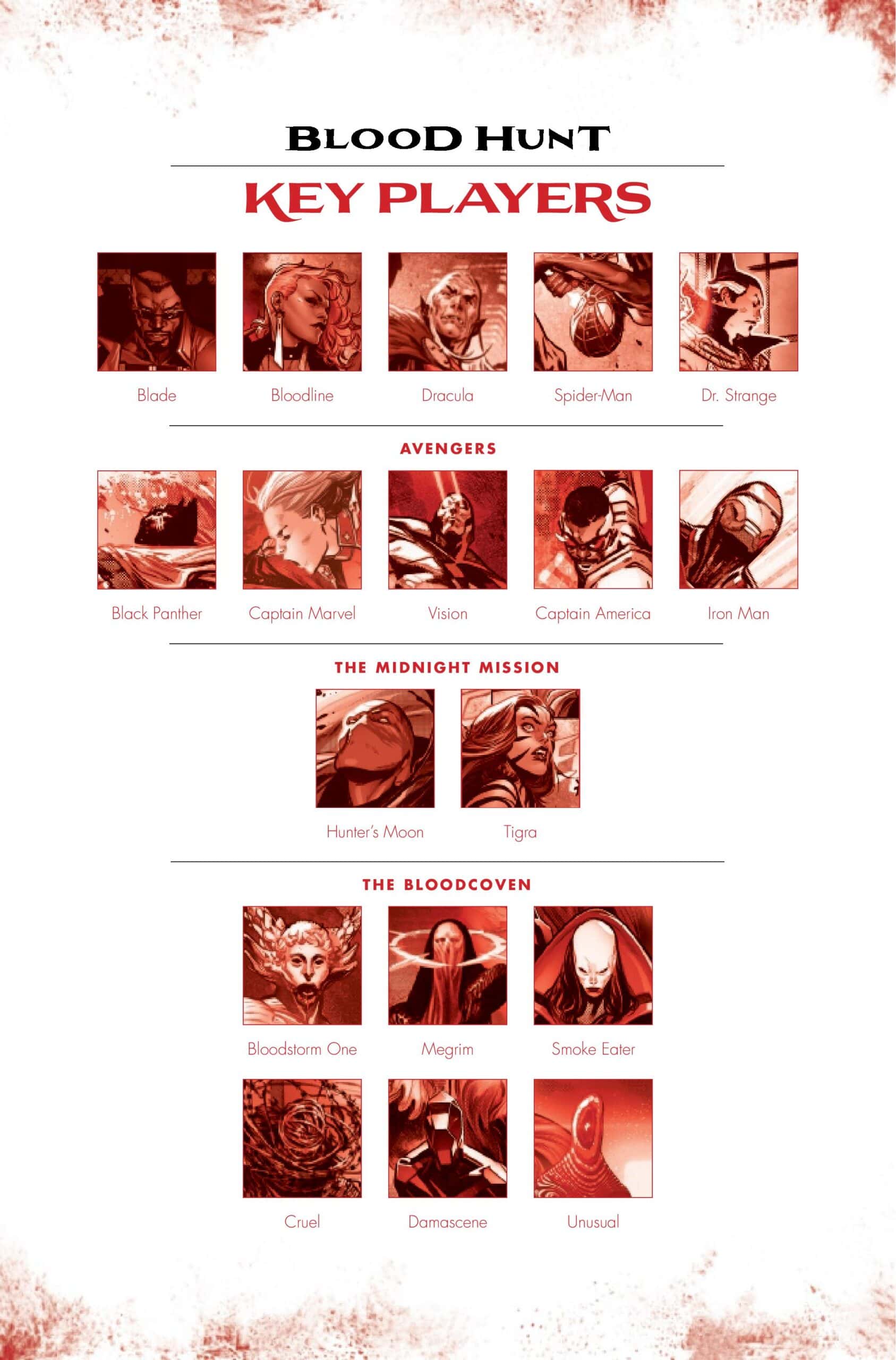Blood Hunt #2

Recap
The vampires' first strike has laid low the world, and their endless legions run riot across the planet. The broken Avengers join the fighters of the Midnight Mission and unlikely allies BLOODLINE and DRACULA in seeking out the one man who can do something about this: Doctor Strange. But after the apocalyptic events of BLOOD HUNT #1, what is left of Earth's Sorcerer Supreme?
Review
Warning: Spoilers Ahead for Blood Hunt #1 and #2
An issue with the last few years of comic book events has been the sense of – nonevents – they’ve seemed like. Just like Hollywood blockbusters feeling spectacle-light, the big Marvel events like Contest of Chaos, Gang War, and Darkhold have felt like specters of the past storylines. A few outliers like Judgment Day, Devil’s Reign, and X of Swords snuck their way through mostly thanks to the excitement of the X-Men titles. However, the lull of oversaturation for events and less than compelling creative teams or storylines compounded to feed the notion of event fatigue. What makes the current event, Blood Hunt, so refreshing is a direct sense of opposition to those flaws.
Blood Hunt #2 – scripted by Jed MacKay with art by Pepe Larraz, coloring by Marte Gracia, and lettering from VC’s Cory Petit – continues the vampire’s invasion of Earth, united under the villainous banner of Blade. The former Avenger turned antagonist is now in control of the Impossible City, taking out the heavy hitters of the team like Black Panther and Scarlet Witch. The Bloodcoven, a new team of super-vampires with Avengers neutralizing powers turn their attention to Dracula and Blade’s daughter Bloodline, who began a team-up in their tie-in.

Meanwhile, chaos reigns on Earth as MacKay favorites like Tigra, Hunter’s Moon, and Spider-Man (Miles Morales) head to Doctor Strange for help. The Sorcerer Supreme is out of commission and in his astral form due to the last issue’s cliffhanger, and it becomes clear that the heroes will have to be a bit more resourceful to stop the invasion. A bit of light makes its way back to the hero’s side however, as some of the surviving Avengers regroup and take the fight back to the Bloodcoven. They manage to return if just for a moment, bits of sunlight to the world as the villainous vampire group retreats.
MacKay’s scripting moves at a bombastic pace, allowing for the heavy action sequences to feel appropriate in scope and tone. The issue splits its time between establishing a bit more of Blade’s motives while still teasing more about the larger backstory turns, weaving in elements of the various tie-ins, and selling the blockbuster action set-pieces to strong effect. This feels like a natural elevation of the approach MacKay has taken in the writing of books like Moon Knight, which managed to juggle over 30 issues of recent continuity while weaving around standout moments and larger Marvel continuity. Moreso, it gives the book a feeling of a peak 2000s Brian Michael Bendis Marvel event, trading in equal parts shared continuity and top-of-the-game fight sequences.

There’s also an excellent threading of recent (the last year or so) continuity and longer Marvel running plotlines from the last five-ish. The Blade twist is unexpected but feels in line with the darker path the hero descended on within his last limited series. The vampire uprising and consolidation of powers grows straight from MacKay and Federico Sabbatini’s installments of Moon Knight and Jason Aaron’s Dracula-centric arcs in Avengers. There’s even a bit of connective tissue with Benjamin Percy’s early issues of Wolverine popping up. It takes a deft hand to streamline and make that sense of history feel accessible to new fans while ensuring it doesn’t feel diminished or retconned for simplicity’s sake. MacKay’s script is willing to play ball with the landscape of the Marvel universe, and shows the stronger for it, even when he also throws in original elements like the Bloodcoven or Darkforce manipulations.
Much of that balance is a direct result of Larraz’s pencils, which wring every bit of drama and detail from the script and transpose it into a beautiful set of pages. Even as the horrors of the vampires and vicious carnage found in fighting infect the pages, there is a quiet beauty to the linework. These are the slick, rhapsodic depictions of the Marvel universe, thriving in the high pressure of the situation. Tensions are at 11 across the pages, and even the less action-centric dialogue sequences are utterly captivating. Larraz’s pages effortlessly flutter between cinematic scopes and focused close-ups to deliver jaw-dropping levels of detail to backgrounds and anatomy, making clear the insane levels of thought that have gone into the book.

Establishing that sense of scale pays dividends when the book breaks into its action sequences, which feel like escalations of the work Larraz created during his X-tenure. Every punch throw or energy blast materialized feels dynamic on the page and carries a weight that sells the damage inflicted or raw emotion bubbling out. The linework embodies the idea of action being necessary when emotions flare beyond expression through speech. Kinetic movements and detailing in anatomy sell the actions characters like Captain Marvel and Vision take, casting no doubt these figures deserve the term heavy hitters.
The action feels just as fluid when the more street-level characters like Bloodline, Hunter’s Moon, and Tigra battle their vampiric foes. Instead of the bombastic, sprawling attacks seen with the Avengers, the Midnight Mission crew operates in precision to defeat the nightstalkers. It’s an excellent division of visual storytelling that illustrates how Larraz fundamentally understands the core ethos of the Marvel universe.

If Larraz elevates this book with the quality of linework, then Garcia deserves as much, if not more, for making this as close to a perfect comic as possible. The coloring twists and adapts the lighting to masterful effect, not just elevating the images but also weaving them into the storytelling of the issue. The energy beams and magical attacks would not feel as effective without the variations of hues that sell the rippling power in each moment. Captain Marvel blasts cool blue beams that feel more mystical than the usual cosmic power. Iron Man’s purple vibrations resemble the powers of Black Panther’s vibranium weapons and oscillate in a way that echoes its sonic nature. These effective choices in colors are captivating and enhance every moment of the story and artwork, working like a fine glue to hold the issue together.
Like the best uses of palettes and tones, Gracia knows when to break out the softer golden hues of sunlight to evoke a swelling sense of hope during the Avengers fight sequence. Of the millions of different subtle tones that could have been used to depict the sunlight returning to Earth, Gracia finds the exact shade of golden yellow that embodies the regal lighting of clouds breaking after an oppressive storm. Like a swelling orchestra in a film, Gracia’s coloring makes the case for the synergy of elements to create a final product, building bridges in craft to convey the full range of emotion on the page and to the reader.
Final Thoughts
Blood Hunt #2 continues to solidify the story as the seminal event of the post-Secret Wars Marvel landscape. From its tight stringing of continuity across modern stories to bombastic artwork and rapturous coloring, the issue makes the case for why events should come together. MacKay sells the premise primarily through character and shared histories while Larraz takes the notions and ratchets them to 12 through the next-level pencils. Gracia brings together all the various elements with a sense of coloring that borders on the majestic. Blood Hunt #2 is the absolute standard that the big two should be working towards with their events, and it's an absolute joy to see the House of Ideas understand and put their weight behind this team.
Blood Hunt #2: Light Finds A Way
- Writing - 10/1010/10
- Storyline - 10/1010/10
- Art - 10/1010/10
- Color - 10/1010/10
- Cover Art - 10/1010/10





